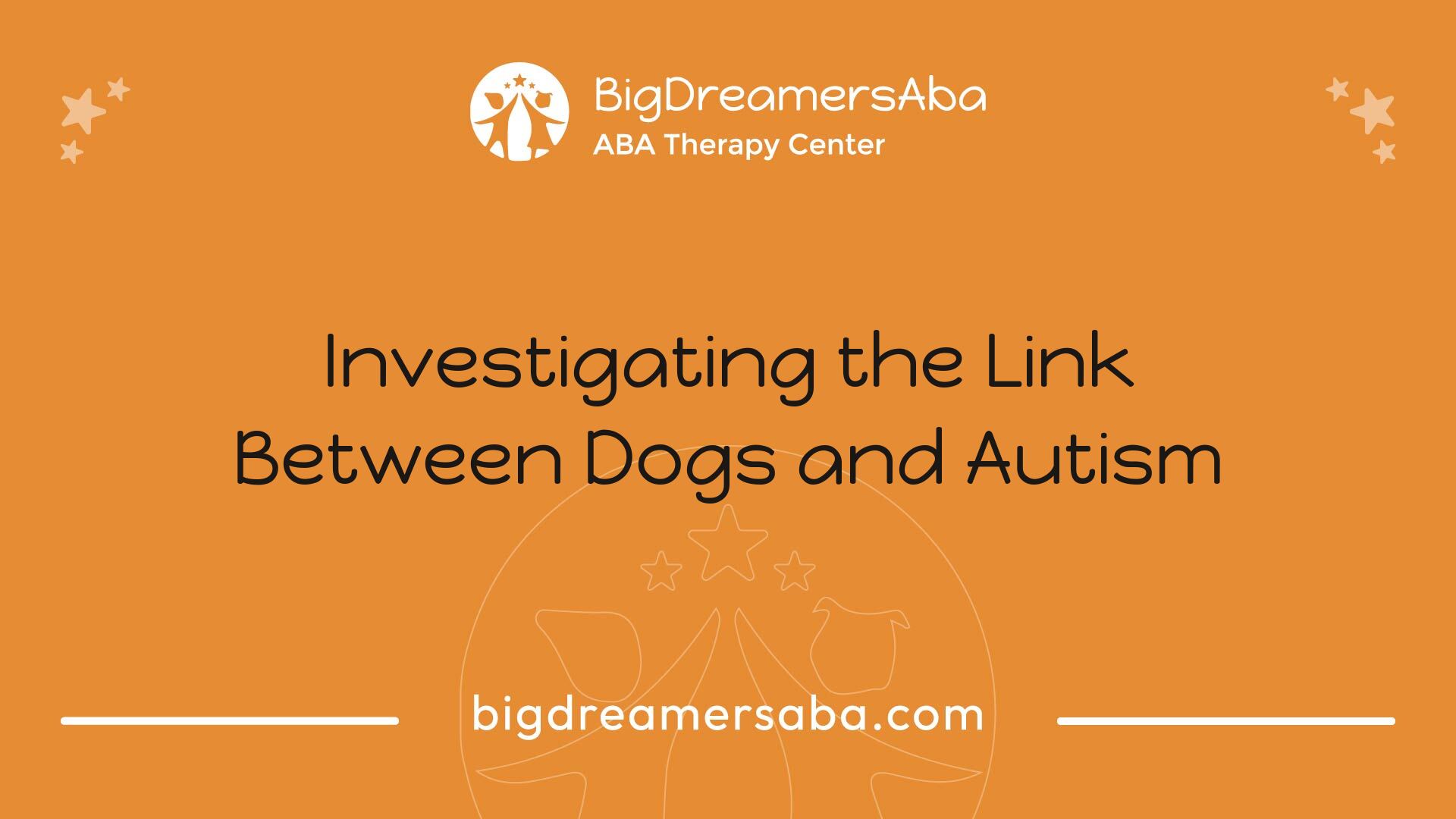Investigating the Link Between Dogs and Autism
Can dogs have autism? Discover the signs, research, and treatments for autism-like behaviors in dogs.


Understanding Autism in Dogs
Understanding the behaviors associated with autism in dogs can help pet owners provide better care and support for their furry companions. While research is limited, certain behavioral traits have been identified that may indicate autism-like behaviors in canines.
Behavioral Traits in Autistic Dogs
Dogs that may exhibit traits akin to autism often show various antisocial behaviors. These behaviors include a lack of interest in interacting with other animals or humans, avoiding eye contact, and not paying attention during walks or playtime. Such behaviors can significantly impact a dog's interactions with its environment and the people around it.
In addition to social disinterest, repetitive motions and obsessive behaviors are common indicators. Examples of these behaviors include:
Behavioral TraitDescriptionCircling a RoomA dog may continuously walk in circles, showing signs of stress or obsessive behavior.Chronic Tail-ChasingThis behavior indicates a fixation that can detract from normal activities.Obsessive ChewingDogs may fixate on chewing specific items without breaking focus.
These traits could signal underlying issues that may require attention.
Signs of Autism-Like Behavior
While dogs cannot technically have autism, they can exhibit behaviors that resemble those seen in autistic individuals. Such behaviors may include repetitive actions or challenges with social interactions. Factors responsible for these traits may range from anxiety and fear to insufficient socialization experiences [2].
It's essential for dog owners to differentiate these behaviors from those caused by other factors. Understanding the root cause can lead to more effective management of the dog's behavior and improve the overall well-being of the animal. For more insights on managing behavioral issues in dogs, exploring resources on environmental causes & risk factors of autism can be beneficial.
Can Dogs Have Autism?

The question of whether dogs can have autism has garnered interest in both scientific and pet owner communities. While there are observable behaviors in dogs that might mimic autism symptoms in humans, understanding the nuances can help clarify the relationship between canine behavior and autism.
Scientific Research Findings
Recent research has proposed that domestic dogs (Canis familiaris) could serve as a model for studying neuropsychiatric conditions, including autism spectrum disorder (ASD) in humans [3]. Although dogs can exhibit certain behaviors similar to those seen in autistic individuals, knowledge about autism in dogs remains limited.
Studies suggest that some dogs may display behavioral conditions that overlap with autism-like traits. For instance, dogs may exhibit impulsivity, social awkwardness, and repetitive behaviors. However, it is crucial to recognize that while dogs may show these traits, they do not experience autism in the same manner as humans due to differences in cognitive and social capacities [4].
Differentiating Autism from Other Behaviors
To effectively answer the question, "can dogs have autism?", it’s essential to delineate between autism and other behavioral issues that may appear similar. Dogs can experience a range of behavioral disorders, including anxiety, fear-based behaviors, and developmental issues. Understanding the distinctions is key for diagnosis and treatment.
Behavior TypeDescriptionComparison to AutismAutism-like BehaviorsImpulsivity, social withdrawal, repetitive actionsMay share traits with human autism but lacks formal diagnosisAnxiety DisordersExcessive barking, chewing, or urinating under stressRooted in fear or trauma, differing motivations compared to autism behaviorsDevelopmental DisordersDelays in learning commands or social interactionsFocused on a lack of exposure or negative experiences rather than neurodevelopment
It is vital for pet owners and researchers to seek professional evaluations when observing concerning behaviors in dogs. Behavioral conditions often have diverse origins and may require specialized interventions, differing from autism diagnosis in humans.
For further resources and understanding, exploring related topics such as speech delay vs. autism may provide additional insights into developmental concerns in both humans and dogs.
Managing Autism-Like Behaviors

When dogs display behaviors akin to autism, managing these tendencies effectively is vital for their well-being. A combination of treatment approaches and behavioral training can provide the necessary support in such situations.
Treatment Approaches
To manage repetitive behaviors in dogs exhibiting autism-like symptoms, integrating mental and physical stimulation into their daily routine is essential. Some effective treatment methods include:
Treatment MethodDescriptionRoutine EstablishmentHelps build security and predictability in a dog's life.Environmental StabilityReduces anxiety by providing a consistent setting.Professional GuidanceVeterinarians or behaviorists can create personalized management plans.MedicationAnti-anxiety or antidepressant medications can be utilized in some cases.
Behavioral Training for Dogs
Training methods for dogs displaying autism-like behaviors should prioritize positive reinforcement. Adopting the following strategies can enhance training effectiveness:
Training StrategyKey PointsPositive ReinforcementRewarding good behavior to encourage repetition.ConsistencyUsing the same commands to promote learning.Patience and EmpathyFostering a supportive environment for better outcomes.
Combining effective treatment approaches with tailored training strategies can significantly improve the quality of life for dogs exhibiting autism-like behaviors. Consulting with professionals aids in achieving a comprehensive management plan, ensuring both the dog's needs and owners' expectations are met. Individuals concerned about their pets should always seek informed guidance from experts.
Autism Spectrum Disorder in Children
Understanding Autism Spectrum Disorder (ASD) in children is crucial for early identification and effective intervention. The diagnosis process is reliant on behavioral observation rather than laboratory tests.
Identification and Diagnosis
Doctors diagnose autism spectrum disorder (ASD) by observing the behaviors of children and listening to parents' concerns. This process typically begins during routine checkups at 18- and 24-month intervals. Pediatricians evaluate developmental milestones and look for any developmental problems or concerns. If any issues arise, referrals to specialists for further assessments are common.
The evaluation for ASD diagnosis involves a collaborative team of specialists, including:
SpecialistRoleChild PsychologistAssesses emotion and behaviorSpeech-Language PathologistEvaluates language and communicationOccupational TherapistAnalyzes daily life skillsDevelopmental PediatricianReviews overall child developmentNeurologistTests cognitive functioning
An official diagnosis is made based on the criteria set by the Diagnostic and Statistical Manual of Mental Disorders (DSM-5) [7].
Early Intervention and Diagnosis
Early intervention is critical for children diagnosed with ASD. Research indicates that the earlier the intervention, the better the outcomes in terms of social and communication skills. Early testing can help identify children who exhibit signs of autism, enabling families to access necessary resources and support services.
If parents observe potential red flags, such as delayed speech or lack of interest in social interactions, they should consult healthcare professionals. Continuous monitoring and evaluations can lead to timely and appropriate interventions. Support can include special education services, behavioral therapies, and resources like new mexico autism resources or new jersey autism resources.
In summary, the identification and intervention for Autism Spectrum Disorder are pivotal steps in providing children with the necessary support for their development. Understanding these processes and seeking help when needed can significantly impact a child's quality of life.
Support and Treatment for ASD
Therapeutic Approaches
While there is no cure for Autism Spectrum Disorder (ASD), various therapeutic approaches can significantly enhance the lives of individuals affected by the disorder. These methods focus on reducing symptoms, fostering development, and supporting learning. Early intervention plays a critical role in improving outcomes for children with autism. The American Academy of Pediatrics recommends screening for autism at all 18- and 24-month well-visits, with treatment commencing as soon as a developmental delay is suspected.
Common therapeutic approaches include:
Early intervention during the preschool years is essential for teaching critical social, communication, functional, and behavioral skills [9].
Long-term Management
Long-term management of ASD involves continuous support throughout life. Although children with autism continue to learn and adapt, they typically require ongoing assistance in various areas. Transition planning is vital for individuals with ASD to prepare for adulthood. This includes considerations for:
Area of FocusDescriptionEmploymentExploring job opportunities suited to abilities and interests.CollegeProviding support for higher education, if appropriate.Living ArrangementsEnsuring suitable and safe living conditions that promote independence.IndependenceDeveloping life skills for self-sufficiency and daily living.Support ServicesIdentifying and accessing community resources that assist in daily life.
Healthcare providers can recommend a mix of home-based and school-based interventions tailored to the individual’s unique needs. Planning for the future is essential to ensure that individuals with ASD have the necessary support services in place for a smooth transition into adulthood. For more information on autism and resources available, check out our new mexico autism resources and new jersey autism resources.
Complementary Therapies for Autism
When addressing autism and autism-like behaviors in dogs, various complementary therapies can be utilized alongside traditional treatments. These alternatives often focus on enhancing communication, reducing anxiety, and promoting emotional well-being.
Alternative Treatments
Several alternative treatments may help manage symptoms associated with autism spectrum disorder (ASD) in both children and dogs. While these treatments are not universally applicable, some may offer benefits depending on the individual's needs:
Treatment TypeDescriptionBehavioral TherapyAims to modify specific behaviors through reinforcement. Dogs may benefit from training programs that focus on social skills and reducing anxiety.Occupational TherapyHelps individuals develop skills for daily living. In dogs, this could involve training to enhance interaction with people and other animals.MedicationIn some cases, medications like anti-anxiety drugs or antidepressants may be prescribed to alleviate symptoms and improve quality of life for dogs.Environmental EnrichmentInvolves providing mental and physical stimulation through toys, puzzles, and activities to reduce boredom and anxiety in dogs.
While these alternatives can be beneficial, working closely with a healthcare professional to develop a comprehensive plan is essential.
Consultation and Considerations
Consulting with a veterinarian or a behaviorist is crucial in managing autism-like behaviors in dogs. Differentiating between anxiety and autism-like symptoms can be challenging, but professionals can provide valuable insights. For instance, repetitive behaviors exhibited when left alone may indicate separation anxiety rather than autism [6].
Regular evaluations and adjustments to treatment plans are necessary to ensure effectiveness and to accommodate the evolving needs of the dog. Additionally, it's important to consider the unique characteristics of each dog and the context in which behaviors occur. By fostering a supportive environment that includes consistent routines and appropriate stimulation, pet owners can help their dogs thrive.
For parents of children with ASD, similar consultations are vital. Knowing about potential therapies that align with the child's needs can enhance overall well-being and effectiveness. More information on managing autism can be found by exploring resources on topics such as environmental causes & risk factors of autism and autism laws and policies.
Recent articles
.jpg)
Autism Services for Kids in Maryland

In-Home Support Services for Autism
